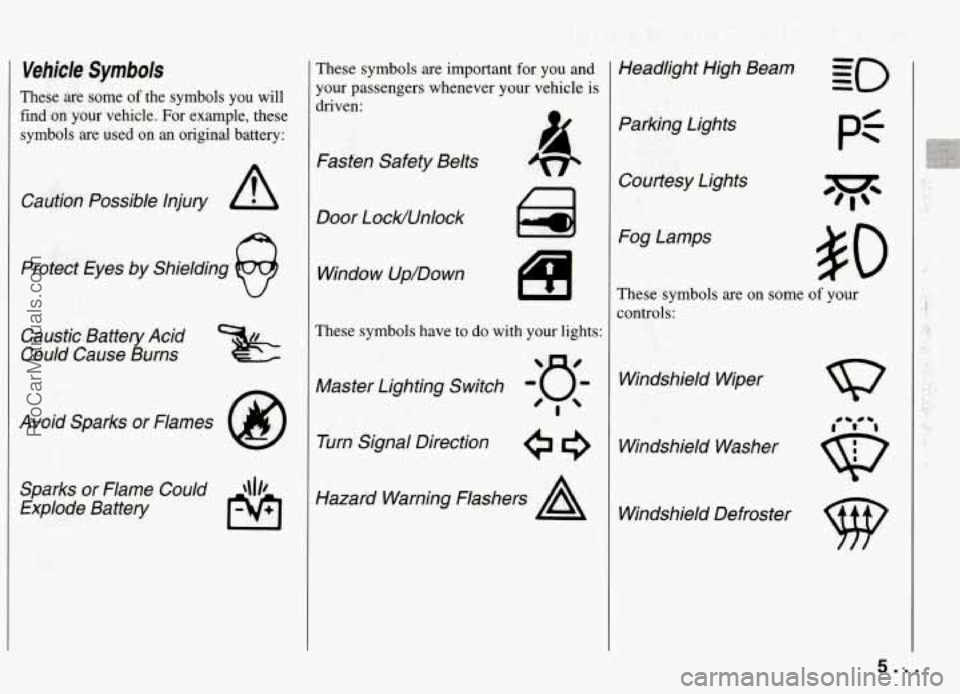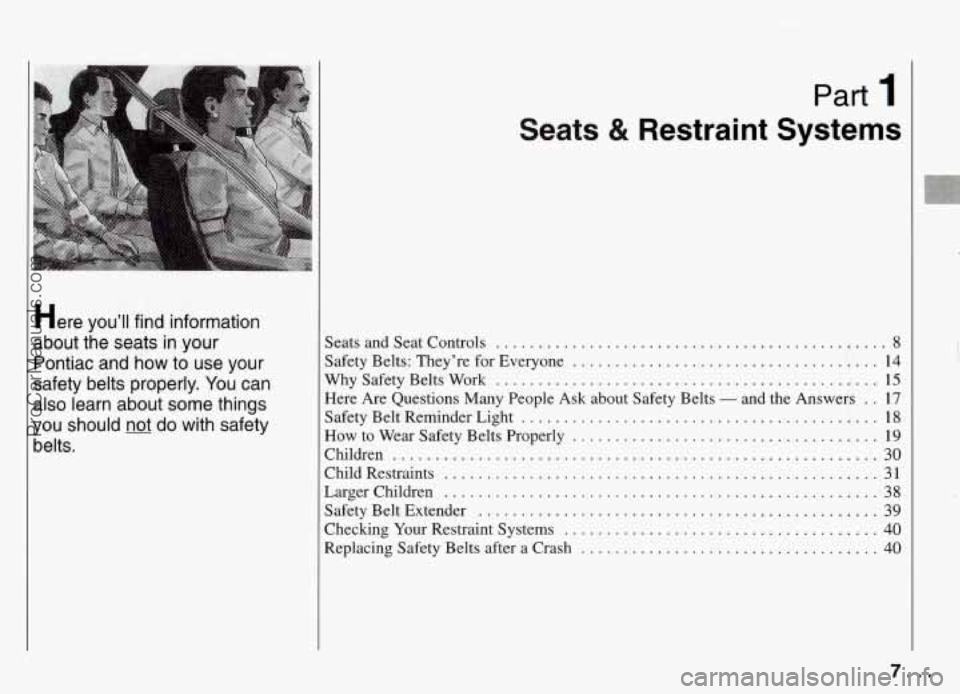belt PONTIAC FIREBIRD 1994 Owners Manual
[x] Cancel search | Manufacturer: PONTIAC, Model Year: 1994, Model line: FIREBIRD, Model: PONTIAC FIREBIRD 1994Pages: 290, PDF Size: 14.84 MB
Page 4 of 290

How to Use This
Manual
Many people read their owner’s manual
from beginning to end when they first
receive their new vehicle. This will help you learn about the features and controls
for your vehicle. In this manual, you’ll
find that pictures and words work
together to explain things quickly.
~ Index: A good place to look for what
you need is the Index
in back of the
manual. It’s an alphabetical list of all
that’s in the manual, and the page
number where you’ll find it.
Parts 1-8: Each part of this manual
begins with a brief list of its contents,
so
you can often find at a glance if a part
contains the information you want.
How to Use This Manual: This part
tells you how to use your manual and
includes safety and vehicle damage
warnings and symbols.
Part 1 - Seats & Restraint Systems:
This part tells you how to use your seats
and safety belts properly.
It also
explains the air bag system.
Part 2 - Features & Controls: This
part explains how to start and operate
your Pontiac.
Part 3 - Comfort Controls & Audio
Systems:
This part tells you how to
adjust the comfort controls and how
to
operate your sound system.
Part 4 - Your Driving and the Road:
Here you’ll find helpful information
and tips about the road and how to drive
under different conditions.
Part 5 - Problems on the Road: This
part tells you what to do if you have a
problem while driving, such as a flat
tire or engine overheating, etc.
Part 6 - Service & Appearance
Care:
Here the manual tells you
how to keep your Pontiac running
properly and looking good.
Part 7 - Maintenance Schedule:
This part tells when to perform vehicle
maintenance and what fluids and
lubricants to use.
Part 8 - Customer Assistance
Information:
This part includes
important information about reporting
safety defects and gives
you details
about the “Roadside Assistance” program.
You will also find customer
satisfaction phone numbers (including
customer satisfaction numbers for the
hearing and speech impaired), as well
as the mediatiodarbitration procedure.
We’ve also included ordering
information for service publications in
this part.
Service Station Information: This is
a quick reference of service
information.
You can find it on the last
page of this manual.
3...
ProCarManuals.com
Page 6 of 290

Vehicle Symbols
These are some of the symbols you will
find on your vehicle. For example, these
symbols are used on
an original battery:
Caution Possible Injury A
Protect Eyes by Shielding
@
Caustic Battery Acid
Could Cause Burns
Avoid Sparks or Flames
8
Sparks or Flame Could \\b
Explode Battery m
These symbols are important for you and
your passengers whenever your vehicle is
driven:
Fasten Safety Belts
Door LocWUnlock Window Up/Down
a
These symbols have to do with your lights:
Master Lighting Switch
Turn Signal Direction
Hazard Warning Flashers
A
A
Headlight High Beam
Parking Lights
Courtesy Lights
Fog Lamps
These symbols are on some of your
controls:
Windshield Wiper
Windshield Washer
Windshield Defroster
5..
ProCarManuals.com
Page 8 of 290

Here you’ll find information
about the seats in
your
Pontiac and how to use your
safety belts properly.
You can
also learn about
some things
you should
not do with safety
belts.
Part 1
Seats & Restraint Systems
..’,
Seats and Seat Controls ............ ........... 8
Safety Belts: They’re for Everyone
........ ..................... 14
Why Safety Belts Work ............................................. 15
Here Are Questions Many People
Ask about Safety Belts - and the Answers . . 17
Safety Belt Reminder Light
.......................................... 18
How
to Wear Safety Belts Properly .................................... 19
Children ................................. ..................... 30
Child Restraints
...... .............. ..................... 31
Larger Children
........................... ..................... 38
SafetyBeltExtender
............................................... 39
Checking Your Restraint Systems
..................................... 40
Replacing Safety Belts after a Crash ................................... 40
c
?..-
ProCarManuals.com
Page 15 of 290

Seats and Restraint Systems
Safety Belts: They’re
for Everyone
This part of the manual tells you how to
use safety belts properly. It also tells you
some things you should not do with safety
belts. And it explains the Supplemental
Inflatable Restraint, or “air bag” system.
’his figure lights up as a reminder to
uckle up. (See “Safety Belt Reminder
.ight” in the Index.)
n many states and Canadian provinces,
he law says to wear safety belts. Here’s
vhy: They work.
You never know if you’ll be in a crash. If
you do have a crash, you don’t know
if it
will be a bad one.
A few crashes are mild, and some crashes
can be
so serious that even buckled up a
person wouldn’t survive. But most
crashes are in between. In many of them,
people who buckle up can survive and sometimes walk away. Without belts they
could have been badly hurt or killed.
After more than
25 years of safety belts in
vehicles, the facts are clear. In most
crashes buckling up does matter
... a lot!
. . .I4
ProCarManuals.com
Page 16 of 290

Why Safety Belts' Work
When you ride in or on anything, you go
as fast as it goes.
For example, if the bike is going 10 mph
(16 kmk), so is the child. When the bike
hits the block, it stops. But
the child keeps going! Take the simplest vehicle. Suppwe it's
just a seat on wheels. -. I' .
ProCarManuals.com
Page 18 of 290

or the instrument panel ... x- the safety belts!
With safety belts,
you slow down as the
vehicle does.
You get more time: to stop.
You stop 'over more distance, and your
gtrongest bones take the forces. That's
why safety belts make such good sense.
H&e &e Questions
Many People Ask about
Safety Belts - and the
Amswers
'Q: Won't I be trapped in tlie vehicle
after an aecidemt if I'm wearing a
safety belt?
A: You could be - whether you're
wearing a safety belt or not. But you
can easily unbuckle a safety belt,
even if you're upside down. And
your
chance .of being conscious during and
after an accident,
so you can unbuckle
and get out,
is much greater if you are
belted.
17.. .
ProCarManuals.com
Page 19 of 290

Seats and Restraint Systems
Q: Why don’t they just put in air bags
so people won’t have to wear safety
belts?
A: Air bags, or Supplemental Inflatable
Restraint systems, are in some vehicles today and will be in more
of them in the future. But they are
supplemental systems only
- so they
work
with safety belts, not instead of
them. Every air bag system ever offered for sale has required the use
of safety belts. Even if you’re in a
vehicle that has air bags, you still
have
to buckle up to get the most
protection. That’s
true not only in
frontal collisions, but especially
in
side and other collisions.
Q: If I’m a good driver, and I never
drive far from home, why should
I
wear safety belts?
A: You may be an excellent driver, but
if you’re in an accident
- even one
that isn’t your fault
- you and your
passengers can be hurt. Being a good
driver doesn’t protect you from things
beyond your control, such as bad
drivers.
Most accidents occur within
25 miles
(40 km) of home. And the greatest
number of serious injuries and deaths
occur at speeds of less than
40 mph
(65 km/h).
Safety belts are for everyone.
Safety Belt Reminder
Light
When the key is turned to “Run” or
“Start,” a chime
will come on for about
eight seconds to remind people to fasten
their safety belts, unless the driver’s safety belt is already buckled. The safety
belt light will also come on and stay on
until the driver’s belt is buckled.
. . .I8
ProCarManuals.com
Page 20 of 290

How to Wear Safety
Belts Properly
Adults
This section is only for people of adult
size.
Be aware that there are special things to
know about safety belts and children. And
there are different rules for smaller
children and babies.
If a child will be
riding in your Pontiac, see the section
after this one, called “Children.” Follow
those rules for everyone’s protection.
I
First, you’ll want to know which restraint
systems your vehicle has.
We’ll start with the driver position.
Driver Position
This section describes the driver’s
restraint system.
Lap-Shoulder Belt
The driver has a lap-shoulder belt. Here’s
how to wear it properly.
1. Close and lock the door.
2. Adjust the seat (to see how, see
“Seats” in the Index)
so you can sit up
straight.
19 ...
ProCarManuals.com
Page 21 of 290

Seats and Restraint Systems
&e ,,, " &
3. Pick up the latch plate and pull the
belt across you. Don't let it get
twisted.
4. Push the latch plate into the buckle
until it clicks.
Pull up on the latch plate to make sure
it
is secure. If the belt isn't long
enough, see "Safety Belt Extender" at
the end of this section.
Make sure the release button on the
buckle is positioned
so you would be
able to unbuckle the safety belt
quickly if you ever had to.
I L-> I'
L
5. To make the lap part tight, pull down
on the buckle end of the belt as you
pull up
on the shoulder belt. The
lap part
of the belt should be worn
ow and snug on the hips, just touching
he thighs. In a crash, this applies force to
he strong pelvic bones. And you'd be
ess likely to slide under the lap belt. If
rou slid under it, the belt would apply
orce at your abdomen. This could cause
;erious or even fatal injuries. The
Ihoulder belt should go over the shoulder
tnd across the chest. These
parts of the
lady are best able to take belt restraining
.orces.
The safety belt locks if there's a sudden
;top or crash.
... 20
ProCarManuals.com
Page 22 of 290

Q: What’s wrong with this?
A: The shoulder belt is too loose. It won’
give nearly as much protection this
way.
Q: What’s wrong with this?
A: The belt is buckled in the wrong
place.
2: What’s wrong with this? ,’.,
k The shoulder belt is worn u&er the
arm. It should be worn over the
shoulder at all times.
21 ...
ProCarManuals.com